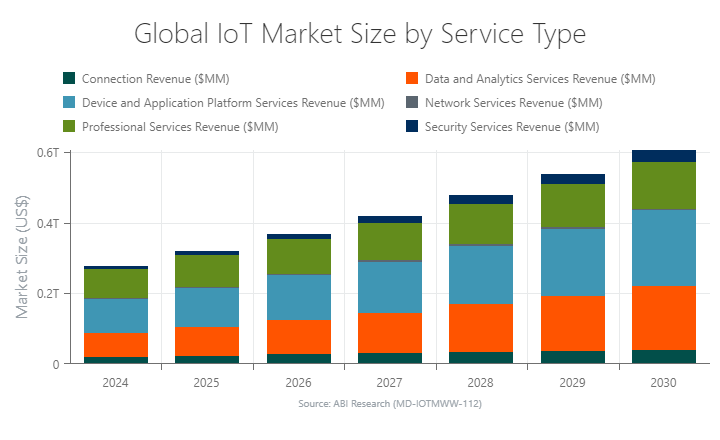IoT Market Sizing Is Forecast to More than Double
ABI Research projects that the global Internet of Things (IoT) market for supply-side software and service revenue is on a steady growth trajectory, increasing in value from US$277 billion in 2024 to US$606 billion by 2030. This rapid expansion reflects the increasing role of the IoT in all industries, from transportation to manufacturing to healthcare.
Device and Application Platform Services Drive the Most IoT Growth, with Data Analytics Services Following
Device and application platform services are leading the charge, accounting for 35% of IoT software and service revenue in 2024 and a dominant 36% by 2030. These services are the backbone of the IoT industry, helping businesses easily monitor, manage, and update devices. Whether tracking a fleet or optimizing production, platforms controlling connected devices and the data they collect are critical to industrial success.
Chart 1: Global IoT Market Size by Service Type

Data analytics services are another key catalyst for the promising outlook, with their market share increasing from 25% to 30% over the forecast period. As more IoT devices are deployed worldwide, companies need advanced analytics to turn all that data into actionable insights. Through data analytics, firms can improve efficiency and decision-making, with Artificial Intelligence (AI) integration playing an increasingly important role.
Professional Services Face Decline
While professional services like consulting and system integration are important, their market share is expected to drop from 29% to 22% by 2030. More companies are now opting for self-service platforms, where they can handle things in-house with less reliance on third-party experts. As IoT use cases proliferate, more reuse of widespread system development knowledge is possible, and less large-scale customization effort is required.
Regional Leaders: United States and China
Geographically, the United States and China will continue to lead the way in IoT software and service adoption. In 2024, the United States will account for 23% of global IoT revenue, and China will hold 18%. By 2030, the U.S. share will slightly decrease to 22%, while China inches up to 19%. Both countries are investing heavily in smart cities, industrial automation, and IoT infrastructure, keeping them at the forefront of the global IoT market.


Top IoT Applications: Telematics and Fleet Management
When it comes to applications, Original Equipment Manufacturer (OEM) telematics and fleet management will dominate the market. These areas are expected to make up 53% of IoT software and services market revenue by 2030. Businesses rely on the IoT to track vehicle performance, manage routes, and cut operational costs.
Another area gaining momentum is condition-based monitoring, which will increase its market share from 7% to 11% by 2030. This technology helps companies monitor the status of assets in real time, predicting equipment failures before they happen, and minimizing costly downtime and truck rolls.
Wrapping It Up
The IoT market is growing rapidly, but organically, and with device and application services, data analytics, and telematics solutions leading the charge, the future looks bright. Businesses that invest in the IoT will gain valuable insights, improve operations, revolutionize their own products and services, and stay competitive in a connected world.
This market sizing was sourced from ABI Research’s IoT Market Tracker - Worldwide market data report, which is part of the company’s IoT Networks & Platforms Research Service.
About the Author
 Jamie Moss, Research Director
Jamie Moss, Research Director
Jamie Moss, ABI Research’s Research Director for Enabling Platforms, covers Machine-to-Machine (M2M), Internet of Things (IoT), and Internet of Everything (IoE) technologies. Jamie conducts competitive analysis, data modeling, and develops front-end analytical tools for products and services in the machine-type connectivity market.
